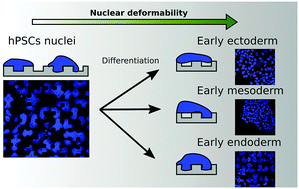Effect of geometrical constraints on human pluripotent stem cell nuclei in pluripotency and differentiation†
Abstract
Mechanical stimuli and geometrical constraints transmitted across the cytoskeleton to the nucleus affect the nuclear morphology and cell function. Human pluripotent stem cells (hPSCs) represent an effective tool for evaluating transitions in nuclear deformability from the pluripotent to differentiated stage, and for deciphering the underlying mechanisms. We report the first study that investigates the nuclear deformability induced by geometrical constraints of hPSCs both in the pluripotent stage and during early germ layer specification. We specifically developed micro-structured surfaces coupled with high-content imaging analysis algorithms to quantitatively characterize nuclear deformability. Our results show that hPSCs possess high nuclear deformability, which does not alter pluripotency. We observed nuclear deformability transition along early germ layer specification: during early ectoderm differentiation nuclear deformability is strongly reduced, during early endoderm differentiation nuclei keep a deformed shape and during early mesoderm specification they show an intermediate behaviour. Different mRNA expressions between hPSCs differentiated on flat and micro-structured surfaces have been observed along early mesoderm and early endoderm specification. In order to better understand the mechanisms of the nuclear deformability transition observed during early ectoderm differentiation, we also employed cytoskeletal and nuclear protein inhibitors to evaluate their role in determining the nuclear shape. Actin and nesprin are essential for maintaining deformed nuclei, while lamin A/C and intermediate filaments confer rigidity to the nucleus. This study suggests that nuclear deformability is highly regulated during differentiation.



 Please wait while we load your content...
Please wait while we load your content...